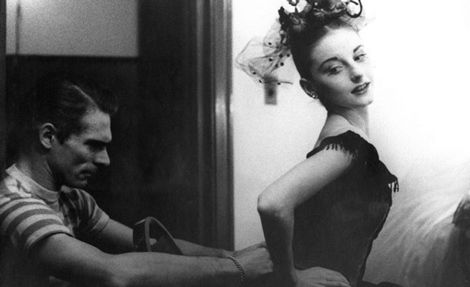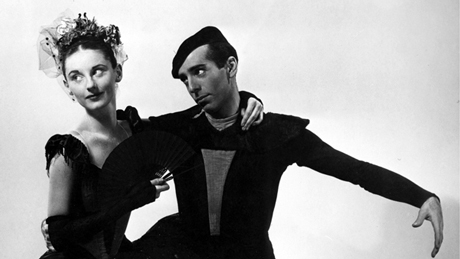Reviewed by Glenn Erickson
There is a kind of film biography that likes to zero in on artistic tragedies such as pianists going blind, singers losing their voices, etc. The example that comes to mind is Interrupted Melody, a tearjerker based on the sad story of Marjorie Lawrence, who was crippled in mid-career. The well-intentioned movie embraces the worst cliché of the genre when Marjorie (played by Eleanor Parker) continues to spread joy and happiness by singing to children in a hospital ward.
I have to say that I'm happy that nobody made such a film about the life of the remarkable Tanaquil Le Clercq. Practically raised for the ballet, 'Tanny' won a place at the School of American Ballet at age 12. By the age of fifteen had caught the attention of George Balanchine, the leading figure in U.S. Ballet. She became a top star, with choreographers and composers creating works for her to dance.

The American Masters documentary Afternoon of a Faun: Tanaquil Le Clercq uses vintage film and kinescopes to tell Le Clercq's impressive story. Fellow dancers and Balanchine's executive assistant appear in lengthy interviews to detail the nuances of the ballerina's character. With her childhood devoted almost entirely to ballet, success opened a new world for her. We hear memories of the young Tanaquil visiting with another closely supervised girlfriend. They had almost no idea what it was like to slip out to see a movie, and perhaps meet a boy. But before Tanaquil was out of her teens she was already attracted to her artistic benefactor, Balanchine, a man 25 years her senior.
A great aid to our understanding are Tanaquil's letters, many of them correspondences with her second collaborator and frustrated love interest, choreographer Jerome Robbins. With input from multiple directions, a fascinating image comes together. Refined but playful, she's an incredibly graceful presence on film or in stills.
We hear very little negative about Tanaquil's dancing style, from any direction. What we see is indeed impressive. Much of the documentary is devoted to descriptions of her qualities that attracted Balanchine and the other choreographers. Le Clercq was unusually tall when most ballet dancers were shorter and more powerfully built. Yet she lacked nothing in grace or control. Her performances are far more than just movement -- in love dances, her head turns mysteriously while her eyes and smile take on a provocative quality. It's no wonder that Balanchine made her his muse, and eventually married her in 1952. Balanchine married four times, each time to a new 'muse'; this seems to have been acceptable at the high end of the dance world. According to the documentary, Jerome Robbins was a disappointed hopeful.

Although a few seconds of brilliant color film are seen, most of Le Clercq's dances are recorded on B&W kinescopes. They were performed for live television before the advent of videotape, when the only way of preserving the show was to shoot it directly from a TV monitor with a film camera. For a kinescope the quality is excellent. We can judge movement well but of course there's almost no texture to the image. Interestingly, Le Clercq's wide, dark eyes record perfectly, and convey well the qualities described by her admirers.
There is a great deal of ballet in Afternoon of a Faun: Tanaquil Le Clercq , along with some very pleasant music for the various dances presented. The Claude Debussy themes used in the piece seems a great fit for the leading ballerina's personality.
Then disaster struck out of the blue. Performing on tour in Copenhagen, Tanaquil literally woke up one morning stricken by polio. It was soon determined that she was paralyzed from the waist down: the handicap could not be overcome. This is where Afternoon of a Faun: Tanaquil Le Clercq really impresses. Instead of milking an obvious tragedy angle, it conveys the practical problems facing Tanaquil. Balanchine sticks by her and exhausts all reasonable avenues of action to cure her, and even suggests unscientific ones. Le Clercq maintains a level head about the whole situation even as she deals with problems in clinics and hospitals. She remains as socially active as possible and is seen on picnics. The docu continues to show her leading an active life, even after her husband Balanchine eventually relocates his affections to a new 'muse' in his professional life. Every ballerina must realize that a time will come when she can no longer dance. Sometimes the body gives out physically just as one has finally attained enough experience to really master one's craft. For Tanaquil, it has just happened sooner, when many years of artistic exploration still lay ahead.

The docu also salts in some ironic facts. When LeClerq first worked with Balanchine as a teenager, the job was a dance to promote the polio charity "The March of Dimes". In the dance, Tanaquil's ballerina is dying until coins tossed in a hat bring her back to health for a happy ending. We also learn the exact reason that Le Clercq didn't receive her polio vaccine, when all of her fellow dancers did. Perhaps the lesson from Afternoon of a Faun: Tanaquil Le Clercq is that there's little sense obsessing over the cause of bad fortune, if the consequences can't be altered. Ms. Le Clercq seems to have personified a positive attitude to personal disaster.

The Kino Lorber DVD of Afternoon of a Faun: Tanaquil Le Clercq is an excellent docu presented in a fine transfer. Rather than crop the images of Le Clercq's dances, the docu changes aspect ratio for the many episodes using vintage kinescopes. The stills accompanying the show are beautifully chosen. Some are by Jerome Robbins, himself (pictured in the photo just above). When action is re-staged it is only for cut-away details; no principal players are represented. Michael Stuhlbarg and Marianne Bower provide the voices when the Robbins-Le Clercq correspondence is heard. The content is so interesting that we're barely aware that a substitution has been made.
For those that catch this review in time, will be premiered on PBS on Friday, June 20. I think viewers will be made more interested in the DVD release -- the show contains a great deal of insider credibility for an almost legendary era in ballet.
On a scale of Excellent, Good, Fair, and Poor,
Afternoon of a Faun: Tanaquil Le Clercq DVD rates:
Movie: Excellent
Video: Excellent with many B&W kinescope segments of vintage quality
Sound: Excellent
Supplements: trailer
Deaf and Hearing Impaired Friendly?
N0; Subtitles: None
Packaging: Keep case
Reviewed: June 11, 2014

Text © Copyright 2014 Glenn Erickson
See more exclusive reviews on the Savant Main Page.
Reviews on the Savant main site have additional credits information and are often updated and annotated with reader input and graphics.
T'was Ever Thus.
Return to Top of Page
|

